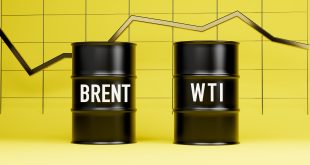Volatility and inflation have been among the most significant key drivers throughout the trading week amid trepulent geopolitical developments with undeniable economic impact across financial market.
Inflation Still Biggest Risk
Data released on Thursday showed that the US consumer price index (CPI) grew 7.9% year-on-year and 0.8% month-on-month in February. The core CPI grew 0.5% month-on-month and 6.4% year-on-year.
Investors have been digesting data showing the highest US inflation in 40 years, which drove US bond yields higher and raised expectations that interest rate hikes could be steeper. The data, though within expectations, added to concerns about the economic recovery from the recent rally in commodity markets.
This could lead to more hawkish action from the US Federal Reserve, which is already expected to hike interest rates when it hands down its policy decision on 16 March. The biggest risk now is inflation.
Even though central banks try and rush to get through as much tightening as possible in the first half of the year, they’re going to struggle if growth really starts to take a hit.
Asian Stocks
The historic surge in oil prices is reshaping the outlook for Asian equities and currency markets, as high prices expose the vulnerability of energy-dependent countries. Risks of a rise in consumer prices and disruption to current-account balances triggered strong foreign outflows from equities in markets like India and South Korea.
The dynamics are slightly different for Chinese markets, where regulatory concerns have been hammering share prices. China imports about 15 per cent of its oil from Russia and may be able to pay lower prices for those imports due to reduced demand from the US and Europe. A wealth of policy tools also means Beijing can order state-owned oil refiners to cut profit to cap fuel prices.
Soaring fuel costs are threatening a nascent recovery in Thailand’s tourism-dependent economy, Asia Pacific stocks were down on Friday morning, with Chinese stocks in the US plummeting to around 14-year lows.
Japan’s Nikkei 225 fell 2.28%. Data released earlier on Friday showed that household spending grew 6.9% month-on-month, but contracted 1.2% year-on-year, in January 2022. The Business Sentiment Index (BSI) Large Manufacturing Conditions index for the first quarter was -7.6.
In Australia, the ASX 200 was down 0.83%, with RBA’s Governor Philip Lowe speaking earlier in the day. Across the Tasman Sea, New Zealand’s Business NZ purchasing managers’ index was 53.6 in February.
China’s Shanghai Composite fell 1.59% and the ShenzhenComponent was down 1.51%. Chinese stocks trading in the US tumbled, with the Nasdaq Golden Dragon China Index plunging 10% on Thursday, its biggest drop since October 2008. This selloff came after the US Securities and Exchange Commission identified five Chinese companies that could be subject to delisting if they fail to comply with certain auditing requirements.
The Kospi Index, which was the region’s biggest 2022 loser among national equity benchmarks before the war began, is down almost 11% year-to-date as rising yields threaten to erode earnings for its tech heavyweights.
The US Dollar
The US dollar has advanced by 0.60% during Friday’s North American session, reflecting a risk-off market mood, as investors sought out to safe-haven peers, considering the US dollar the safest, so the Dollar Index DXY closed trading at 99.119.
The market sentiment fluctuated throughout the week. In the mid-European session, news that Russia-Ukraine talks according to Russia’s President Vladimir Puttin saying that there had been “certain positive shifts” in negotiations with Ukraine. However, late in the day, Ukraine Foreign Minister Dmytro Kubela said on Friday that “there had been zero progress in talks with Russia on Thursday”.
Sanctions on Russia keep escalating. US President Joe Biden on Friday said that the United States will revoke Russia’s “permanent normal trade relations” status to punish Moscow over its invasion of Ukraine. After banning Russian oil and some energy products, the US will ban more imports from Russia, which could disrupt more than $1 billion in export revenues for Russia, according to the White House.
The Russian ruble continued to edge higher against the dollar on Friday, though in thin volume. On Thursday, the Russian central bank placed new restrictions on local access to foreign-currency cash.
US Treasury yields closed mixed, led by the short-term of the yield curve, with 2s, and 5s, rising two-and-half, and one-and-half basis points, respectively up at 1.746% and 1.956%. The 10-year T-note rises one-basis point sits at 2%. Technically, The DXY was upward biased, advancing steadily within Pitchfork’s ascending channel. 10-year US Treasury yield steadied after climbing above 2%, and the 30-year rate hit its highest level since May 2021.
Inflationary pressure is adding to the strain on global markets, with little hope of progress in talks between Russia and Ukraine to end the conflict triggered by Russia’s Feb. 24 invasion of Ukraine. JPMorgan Chase & Co. was the latest addition to the long list of Western businesses and firms pulling out of Russia over the invasion. YouTube and Google Play also suspended payment services in Russia
Gold
The precious metal continued to capitalize on safe-haven flows. Gold Price was trading at around $2,060 per ounce on Tuesday during the US session, overbought but without signs of technical exhaustion.
Gold Price resumed its advance early in the US session and trades near a multi-month high of $2,020.96 per ounce its highest since August 2020. The bright metal resumed its advance early in the American session to hits $2060 per ounce before stabilizing at $2043.40 despite a positive shift in the market’s sentiment.
US stock market indexes kick-start the day with a positive tone following Monday’s slump, although a substantial recovery is yet to be seen.
Investors will continue to pay close attention to geopolitical headlines. Gold has been one of the most sensitive assets to changes in risk mood and it is likely to continue to find demand if tensions continue to escalate.
With a daily close below $1,950 (Fibonacci 38.2% retracement), XAU/USD could test the ascending trend line at $1,940. On the upside, $1,990 (Fibonacci 23.6% retracement) aligns as first technical resistance before $2,000 (psychological level) and $2,010 (static level).
FED
The Fed is widely expected to kick off its tightening cycle with a 25 basis points rate hike when the two-day FOMC policy meeting concludes on Wednesday, 16 March.
ECB
The European Central Bank kept its interest rate steady at 0% as it handed down its own policy decision on Thursday. However, it accelerated its wind-down of monetary stimulus in a surprise move, signaling that the central bank’s focus is on high inflation rather than weaker economic growth.
Energy, Commodities
WTI closed historically volatile week in subdued fashion just under $110. After a historically volatile week, WTI is more subdued on Friday, remaining capped under $110 but supported above $104.
WTI is on course for a weekly drop of over $7.0, which would be its worst one-week performance since November.
Global oil markets look set to end a historic week of energy-related global developments and volatility in comparatively subdued fashion. On Friday, front-month WTI futures, which surged as high as $130 per barrel earlier in the week, have remained capped underneath $110, but also supported above earlier weekly lows in the $104 area.
At latest levels near $108, WTI traded with on-the-day gains of about $2.0, but is on course to post a weekly drop of more than $7.0, which would be its worst one-week performance since November.
Oil markets were buffeted by a barrage of important new developments this week. The US announced a ban on all Russian energy imports, the UK announced plans to phase out imports by the end of the year and the EU is working on a strategy to significantly reduce its exposure to Russian energy imports over the coming years.
While these headlines exaccerbated concerns about oil shortages, with major Western oil buyers already shunning Russian exports, there was also plenty of focus on where new supply could come from.
The oil and gas rig count, an early indicator of future output, rose 13 to 663 in the week to March 11, its highest since April 2020, energy services firm Baker Hughes Co said in its closely followed report on Friday.
Baker Hughes said that puts the total rig count up 261 rigs, or 65%, over this time last year. US oil rigs rose eight to 527 this week, their highest since April 2020, while gas rigs gained rose five to 135, their highest since October 2019.
Commentary from Western and Iranian officials suggests a deal to revive the 2015 nuclear pact is on the cusp of being reached, but new Russian demands this week meant that talks hit a snag, slowing progress to an agreement that could see over 1.3M barrels in Iranian crude oil exports return to global markets.
While mixed messaging from UAE officials this week did suggest there is a debate going on (the UAE’s US ambassador said that the country would push for a larger OPEC+ output hike), the Saudis are yet to cave.
The US is also trying to reach a deal with Venezuela that would see sanctions lifted to allow direct exports to the US, while officials are also looking at ways to up domestic output.
For now, markets appear to be in something of a state of confusion about firstly; how much Russian oil supply is being lost and secondly, how much supply can quickly come online from elsewhere.
Until this becomes clearer, trading conditions are likely to remain historically volatile, with some analysts predicting big further price gains, and others calling the top.
Natural gas prices held in a narrow range Wednesday, flipping between modest gains and losses as traders balanced global supply worries amid the war in Ukraine against the prospect of fading domestic demand.
The April Nymex gas futures contract ultimately shed a tenth of a cent day/day and closed at $4.526/MMBtu. May dipped two tenths of a cent to $4.561. It marked the third consecutive day of declines. NGI’s Spot Gas National Avg. shed 7.5 cents to $4.445.
The outlook for the next two weeks is easily warmer than normal, in stark contrast to the forecasts seen for the middle of the month just a week ago.
The weather change is the primary bearish factor over the last few days, thanks to mid-month colder potential completely vanishing. Last week, futures jumped 12% on expectations for more cold and escalating concerns about Russia’s invasion of Ukraine.
The war fueled surges in global oil and European natural gas prices, due to worries that Russian crude and gas supplies to Europe could be interrupted amid the cold of winter.
US supplies are sufficient for domestic needs, and the market is headed into the spring shoulder season, when heating demand is all but certain to taper quickly.
The market is now looking ahead to the end of the winter season. Forecasts point to comfortably above normal temperatures. Markets remain vulnerable to price swings until there is material de-escalation in Ukraine.
The potential for Europe to follow President Biden’s lead and ban imports of Russian oil and natural gas is a question that traders seek certain answers for. Biden made the move Tuesday, sending global oil prices to new 2022 highs.
Silver (XAG/USD) prices remain capped below the $26.00 level and within Thursday’s intra-day ranges, despite weakness US equities as investors demonstrate skepticism about earlier remarks from Russian President Vladimir Putin alluding to positive developments in talks with Ukraine.
Meanwhile, Western nations continue to ramp up sanctions on Russia, with the G7 moving on Friday to remove Russia’s preferred nation trading status and also pushing to limit Russian access to IMF and World Bank funds.
Jobs Data
The Canadian economy added 336,600 jobs in February, well above the median economist forecast for 160,000 jobs to have been added on the month, a report released by Statistics Canada on Friday showed.
US Initial weekly jobless claims rose to nearly 230,000 during the first week of March, above economists’ expectations. The number of first-time unemployment claims increased by 11,000 to 227,000 during the week ended March 5, according to new data released by the Labor Department on Thursday.
Cryptocurrencies
President Biden ordered federal agencies to study implications of government-backed digital currency. The Federal Reserve is trying to figure out how to keep cash relevant in a cashless world. It is considering digitizing the US dollar, giving people money they can access on their phone and bypassing electronic payments that can be slow and costly for businesses.
Biden’s executive order on cryptocurrencies directs his administration to consider the potential implications of a US digital dollar, which would be backed by the Federal Reserve.
The Fed is already evaluating the possibility of a digital currency, which some other countries, including China, have already adopted.
The move is part of a sweeping executive order President Joe Biden signed Wednesday instructing the federal government to explore possible uses of and regulations for digital assets like cryptocurrencies.
Long hailed by its advocates as a safe hedge during uncertain times, Bitcoin’s value has fallen steadily in recent weeks.
BTC/USD as it again came close to testing $38,000 support during Sunday.
The pair had seen a quiet end to the week on Wall Street. The weekend proving similarly calm as the status quo both within and outside crypto continued without surprises.
Now, attention was already focusing beyond Sunday‘s close, specifically on the upcoming decision on interest rates from the United States Federal Reserve.
Due March 16, the extent of the presumed rate hike could provide temporary volatility and even a longer-lasting trend change for risk assets, depending on their size.
The situation between Russia and Ukraine remained a major focus amid faint signs that consensus between negotiators could be coming sooner rather than later.
For monitoring resource Material Indicators, the Bitcoin chart showed spot price between the 50-week and 100-week moving average prior to the Fed‘s decision.
 Noor Trends News, Technical Analysis, Educational Tools and Recommendations
Noor Trends News, Technical Analysis, Educational Tools and Recommendations





